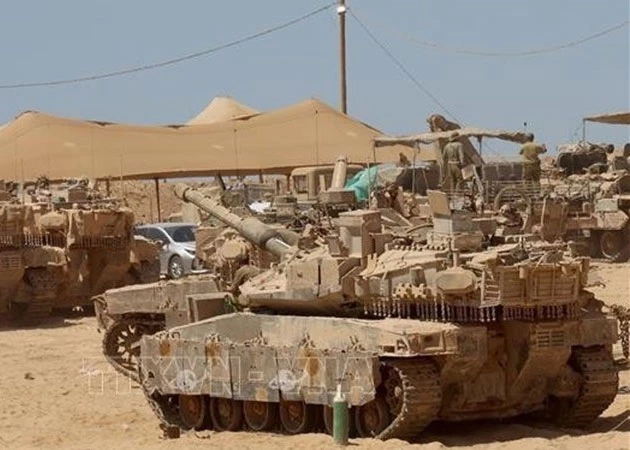‘Cauldron’ boils over with Israel’s controversial Gaza City occupation plan
The plan to occupy Gaza City recently approved by Israel’s Security Cabinet has “poured more fuel” onto the ever-simmering “cauldron” of the Middle East.
 |
| Israeli military vehicles have been deployed near the border with the Gaza Strip. (Photo: Xinhua/VNA) |
On August 8, Israel’s Security Cabinet approved Prime Minister Benjamin Netanyahu’s plan to occupy Gaza City, the largest urban centre in the northern area of the coastal Gaza Strip.
The plan sets out five principles for ending the war, most notably disarming of Hamas; the establishment of a civilian administration not under the control of either Hamas or the Palestinian Authority; and Israel’s continued security control over Gaza.
The move has sparked fierce opposition from the international community and domestically in Israel. Countries and organisations have urged Israel to halt what they describe as a dangerous plan, warning that military escalation will only lead to more bloodshed and suffering, rather than resolving the conflict.
Sharp criticism has come from the families of those taken hostage in the Gaza Strip and from opposition figures across Isreal’s political spectrum, who argue that this decision will place the surviving hostages in grave danger. Numerous protests against the plan have taken place in Tel Aviv.
Under mounting pressure, Israeli Prime Minister Benjamin Netanyahu maintained a hard-line stance at a press conference, declaring that he would not allow Hamas to regain control of Gaza.
According to the Israeli leader, the new plan for Gaza City is “the best and fastest way” to end the war with Hamas. He also asserted that Israel has no intention of permanently occupying the Gaza Strip; its goal is to completely eliminate Hamas fighters.
To understand why Netanyahu chose to focus on Gaza City, one must consider its significance. It is the most densely populated centre in the Gaza Strip.
CBC News quoted former Israeli military officer Amir Aviv as saying that Gaza City is the heart of the Gaza Strip and the nerve centre of Hamas’s governance. Its fall would, in effect, mean the fall of Hamas.
The decision sends a deterrent message to Hamas while signalling Israel’s determination to control the entire Gaza Strip.
Some experts believe the move may be a “tactic” by Tel Aviv to pressure Hamas into making concessions at the negotiating table. However, this “gamble” still puts Israel in a situation where “the benefits outweigh the disadvantages”.
A security strategy lacking careful consideration of political and humanitarian consequences will leave Israel with more to lose than to gain.
Analysts point out that Israel risks losing credibility on the international stage, while eroding the support and trust of its Western allies.
The more gunfire echoes across the battlefield, the narrower the window for reconciliation becomes.
Egyptian President Abdel Fattah El-Sisi declared that Israel has crossed . New escalations are likely to erupt across the Middle East, as the plan could trigger retaliatory attacks.
Hamas has warned that Israel’s move would spell the end for the surviving Israeli hostages.
Meanwhile, Houthi forces continue stepping up attacks on ships in the Red Sea in a show of solidarity with Hamas, forcing the closure of the port of Eilat in southern Israel and cutting off its main source of revenue.
According to the World Health Organization (WHO), since May 27, more than 1,600 people have been killed and nearly 12,000 injured while trying to access food distribution points in the Gaza Strip. The people of this war-torn land face exhaustion and destitution.
Acts of military aggression, rather than dialogue, regardless of the party involved, will only deepen divisions and push the entire region into a new spiral of instability, with an even greater degree of violence.
NDO





READER COMMENTS